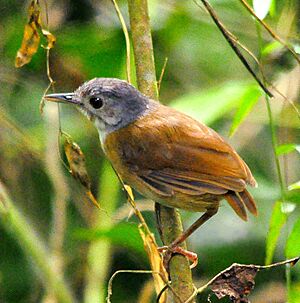Ashy-headed babbler facts for kids
Quick facts for kids Ashy-headed babbler |
|
|---|---|
 |
|
| Conservation status | |
| Scientific classification | |
| Genus: |
Pellorneum
|
| Species: |
cinereiceps
|
| Synonyms | |
|
|
The ashy-headed babbler (Pellorneum cinereiceps) is a small bird that belongs to a group called passerine birds. These birds are often called "perching birds." It's part of the ground babbler family, Pellorneidae. You might also hear it called the ashy-crowned babbler.
This bird is quite similar to the short-tailed babbler, but they have different calls. The ashy-headed babbler is a "monotypic" species, which means it doesn't have any different types or subspecies.
Where it Lives
The ashy-headed babbler is a special bird because it is endemic to one place. This means it is found only on Palawan, an island in the Philippines.
It lives in different kinds of forests. You can find it in old, untouched forests (primary forest) and in forests that are growing back (secondary forest). It also lives in areas with bushes and shrubs, called scrubland.
This bird can be found from sea-level all the way up to about 1,300 meters (4,300 feet) high. The ashy-headed babbler does not migrate, meaning it stays in the same area all year round. Scientists consider this bird to be of "least concern" for its survival.
What it Looks Like
The ashy-headed babbler is a small bird, about 13 centimeters (5 inches) long. It weighs between 22 and 26 grams, which is about the same as a few quarters.
Its head has a grey top, called the crown, and a grey back of the neck, called the nape. The rest of its face is light grey, except for a thin dark line near its beak, called a moustachial stripe.
The bird's back, upper wings, and tail are a brownish-orange color. Its throat, chest, and belly are white. There's a light brownish-orange wash across its chest and along its sides. Its legs are pinkish, and its beak is grey on top and pink underneath. Male and female ashy-headed babblers look the same.
When this bird calls, it makes a sound like a nasal jhieu-jhieu-jhieu-jhieu.
How it Behaves
Scientists don't know a lot about the ashy-headed babbler's daily life. They believe it eats small insects and other tiny creatures without backbones.
It usually looks for food alone or in pairs. It stays close to the ground while foraging. It acts very much like its relative, the short-tailed babbler. This bird is quite curious and often flicks its wings while it's searching for food.
Breeding and Nests
The ashy-headed babbler's breeding season is from April to September. They build their nests on the ground, often at the bottom of rattan plants. Rattan is a type of climbing palm.
The nest is shaped like a cup. It's made from grasses, rattan fibers, and bamboo leaves. The inside of the nest is soft, lined with lichens and moss. Female babblers usually lay two eggs. These eggs can be white with red or brown spots, or they can be blue with dark brown speckles.


